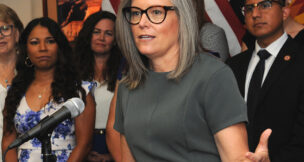Recent Articles from Jim Turner
Tent City Hero
Sporting a pitch helmet, linen suit and big white mutton-chop sideburns, Oliver E. Comstock pedaled his bicycle along Tucson’s dusty roads with a soup kettle hanging from the handlebars. He will never be as famous as Wyatt Earp, but he was a real hero to the residents of southern Arizona’s Tent City.
The Oasis at a Cultural Crossroads
For almost two centuries, Spanish missionaries, mountain men, ’49ers, Civil War soldiers and American settlers benefitted from — and often depended on — the plentiful crops and hospitality of the Pima and Maricopa people.
Global Influence
“It says here Aunt Susie died,” said George Smalley, reading a letter from home at the family dinner table. “Oh, who shot her?” asked his daughter Yndia. It seemed like everyone died that way in Globe in those days.
Times Past: The ‘Mother of Arizona’
Gov. George W. P. Hunt called Josephine Brawley Hughes “the Mother of Arizona.” She fought for women’s suffrage and prohibition of drinking and gambling. She even fought to ban smoking in public. In Arizona’s rowdy territorial days she was often laughed at, but she prevailed courageously.
Geronimo’s Autobiography
In his autobiography, Geronimo told about the lifestyle and beliefs of his people, the Bedonkohe, who lived in the mountains along the eastern border of Arizona. He said he was born in 1829 near the headwaters of the Gila River.
3 generations of photographers in the Old Pueblo
Arriving in Tucson seven years before the railroad, frontier photographer Henry Buehman captured the rapidly vanishing frontier on film. His son Albert Buehman continued the family tradition and gained international renown. Grandson Remick rounded out an 80-year family legacy.
‘No one died a natural death in Globe’
"It says here Aunt Susie died," said George Smalley, reading a letter from home at the family dinner table. "Oh, who shot her?" asked his daughter Yndia. It seemed like everyone died that way in Globe in those days.
The Globe flood of 1904
The rain began as a gentle shower. An hour later, six people were drowned and the damages amounted to half-a-million dollars. They called it the Globe flood, but the official government name was the Pinal Creek Flood, since it was the creek that did the flooding, not the town.
Harry Truman and the Springerville Madonna
The Springerville "Madonna of the Trail" looms 18 feet high across from the Post Office on Main Street, also known as Highway 60. She has 11 identical sisters, each in a different state: Bethesda, Md.; Beallsville, Pa.; Springfield, Ohio; Wheeling, W.Va.; Vandalia, Ill.; Richmond, Ind.; Lexington, Miss.; Council Grove, Kan.; Lamar, Colo.; Albuquerque, N.M. and Upland, Calif.
Arizona’s glittering silver inkwell
Colonel Charles D. Poston, self-named "Father of Arizona," commissioned the opulent treasure while serving as Arizona Territory's first delegate to Congress. He presented it to the president in March 1865, as a gift of appreciation for splitting New Mexico Territory in half to create Arizona in 1863.
Mine with the iron door
"Look for the mine with the iron door, Jimmy," my dad said. When I was about six years old, Dad told me the legend of the lost mine and the Spanish missionaries who mined silver and gold on the north side of the Catalina Mountains. We'd leave Tucson in the dark to hunt quail on Golder Ranch, Owl's Head, or Tecolote northwest of town....
The Great Arizona Outback
The Great Arizona Outback, also known as McMullen Valley, is a little-known locale where the frontier never closed. Hope, Salome, Wenden and Vicksburg are a few of the necklace of towns strung out along a desolate stretch of Highway 60 west of Phoenix. The valley was named after James McMullen, who ran the stage between Congress and Ehrenberg. Wells Fargo took over later and made it part of their [...]






